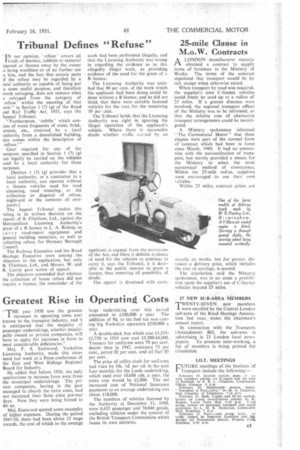Greatest Rise in Operating• Costs
Page 37

If you've noticed an error in this article please click here to report it so we can fix it.
'THEyear 1950 saw the greatest increases in operating costs ever known to the transport industry, and it is anticipated that 'the majority of passenger undertakings, whether municipally owned or private companies, will have to apply for increases in fares to meet considerable deficiencies." .
Maj. F. S. Eastwood, Yorkshire Licensing Authority, made this statement last week at a Press conference of the East and West Ridings Regional Board for Industry.
He added that before 1950, the only applications to increase fares were from the municipal undertakings. The private companies, having in the past managed to absorb the extra costs, had not increased their fares since pre-war days. Now they were being forced to do so.
Maj. Eastwood quoted some examples of higher expenses. During the period 1947-50, there had been about 15 wage awards, the cost of which to the average
large undertaking over this period amounted to £260,000 a year. The addition of 9d. to the fuel tax was costing big Yorkshire operators £530,000 a year.
A double-deck bus which cost £1,335£1,750 in 1939 now cost 0,300-14,000. Trousers for uniforms were 79 per cent. dearer than in 1947. overcoats 75 per cent., petrol 82 per cent, and oil fuel 85 per cent.
The price of utility cloth for uniforms had risen by 10s. ld, per yd. in the past four months; for the Leeds undertaking, which used over 10,000 yds. a year, the extra cost would be £5,000. The net increased cost of National Insurance payments to art average undertaking was about £18,000.
The numbers of vehicles licensed by the Authority at December 31, 1950, were 6,435 passenger and 74,046 goods, excluding vehicles under the control of the British Transport Commission which issues its own statistics. 27 NEW SUB-AREA MEMBERS
TWENTY-SEVEN new members
ere enrolled by the Central London sub-area of the Road Haulage Association last year, states the chairman's annual report.
In connection with the Transport (Amendment) Bill, the sub-area is advertising in 23 London local newspapers. To promote inter-working, a list of members is being printed for circulation.




















































































